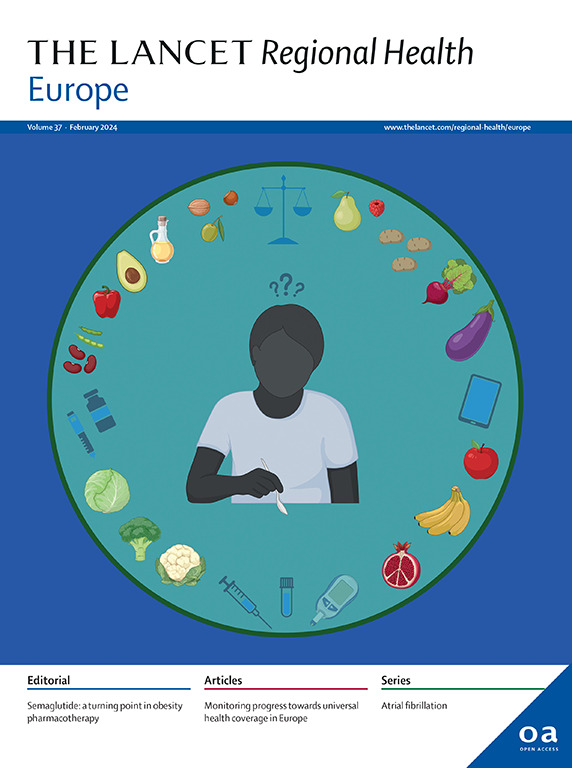英国衣原体检测的在线邮政自我抽样的吸收、积极性和公平性:一项回顾性队列研究
IF 13
Q1 HEALTH CARE SCIENCES & SERVICES
引用次数: 0
摘要
衣原体是欧洲最常见的性传播感染(STI),未经治疗的衣原体与健康状况不佳有关。在线邮政自我抽样使人们能够在不去卫生保健提供者那里的情况下检测包括衣原体在内的性传播感染,但在英格兰增加这种检测模式对不同人群获得检测的影响程度尚不清楚。在英格兰,有国家级的监测数据,能够识别与使用在线邮政自采样(OPSS)进行衣原体检测相关的因素。本分析的目的是确定引入OPSS后衣原体检测、衣原体阳性和检测地点的变化,并确定与OPSS服务的接受相关的社会人口因素,与现场检测相比。方法我们进行了一项回顾性队列研究,分析了2015年1月1日至2022年12月31日期间英国所有公共资助的衣原体检测数据,使用两个假名的国家监测系统(GUMCAD STI监测系统和CTAD衣原体监测系统)检测性传播感染。我们对25,171,919例衣原体检测进行了描述性分析,以确定衣原体检测的吸收和阳性情况,并按检测方式和性别进行了分析。我们使用双变量和多变量逻辑回归来检验接受检测和检测阳性与社会人口学特征的关系,以及通过OPSS或其他模式进行的检测。衣原体检测/季度(OPSS和亲自检测)的总数量随着时间的推移逐渐增加,直到2019年(第一季度为884,843次/季度),然后在2020年初下降(第二季度为376,118次),到2022年底尚未恢复到2019年的水平(第四季度为715,166次)。在此期间,通过OPSS完成的OPSS检测比例从2015年的2.6%(88,144/3,433,987)增加到2022年的38.4%(1,168,828/2,972,226)。与所有可用的现场检测相比,女性使用OPSS的可能性低于男性(aOR = 0.75, 95% CI 0.75 - 0.75)。20-24岁的患者比15 - 19岁的患者更容易使用OPSS (aOR = 1.55, 95% CI为1.55 - 1.56),OPSS的使用随着年龄的增加而减少。最贫困地区的人最不可能使用OPSS(多重剥夺指数五分位数组2-5比1的aor为1.18-1.28)。与面对面检测相比,人们使用OPSS检测阳性的可能性更低(aOR = 0.87, 95% CI 0.87 - 0.88)。2015年至2022年间,男性OPSS衣原体检测阳性从9.3%(2551/27,557)降至7.5%(34,050/454,596),女性从7.4%(4458/60,367)降至6.1%(43,088/702,867)。同期,在性健康服务机构中,男性衣原体检测呈阳性从8.2%(57,139/692,873)增加到10.6%(43,061/406,161),女性衣原体检测呈阳性从6.4%(51,080/797,143)增加到7.9%(33,292/420,760)。解释:我们发现在获得护理方面发生了变化,转向通过OPSS进行检测,在谁在哪里进行检测方面存在差异,在检测模式和性别方面存在阳性差异。需要进一步研究以确保现有的检测途径满足所有人群的需求。资助国家健康和护理研究所。本文章由计算机程序翻译,如有差异,请以英文原文为准。
Uptake, positivity, and equity of online postal self-sampling for chlamydia testing in England: a retrospective cohort study
Background
Chlamydia is the most commonly reported sexually transmitted infection (STI) in Europe and untreated chlamydia is associated with poor health outcomes. Online postal self-sampling enables people to test for STIs including chlamydia without having to visit a health-care provider, but the extent to which the addition of this mode of testing in England has impacted access to testing in different populations is unclear. In England, there is national-level surveillance data enabling identification of the factors associated with use of online postal self-sampling (OPSS) for chlamydia testing. The aim of this analysis was to determine the change in chlamydia testing, chlamydia positivity, and test location as a result of the introduction of OPSS, and to determine socio-demographic factors associated with uptake of OPSS services compared to testing in-person.
Methods
We conducted a retrospective cohort study analysing data on all publicly funded chlamydia tests between 01/01/2015 and 31/12/2022 in England using two pseudonymised national surveillance systems (GUMCAD STI Surveillance System and CTAD Chlamydia Surveillance System) for STIs. We conducted a descriptive analysis of 25,171,919 chlamydia tests to establish the uptake and positivity of chlamydia tests by testing mode and gender over time. We used bivariate and multivariable logistic regression to examine associations of uptake of testing and positivity of tests with sociodemographic characteristics and testing by OPSS or a different mode.
Findings
The overall number of chlamydia tests/quarter (OPSS and in-person) gradually increased over time until 2019 (884,843 tests/quarter in quarter 1) and then declined in early 2020 (376,118 in quarter 2) and had not returned to 2019 levels by the end of 2022 (715,166 in quarter 4). During this time, the proportion of OPSS testing completed through OPSS increased from 2.6% (88,144/3,433,987) in 2015 to 38.4% (1,168,828/2,972,226) in 2022. Women were less likely than men to use OPSS compared to all available in-person testing (aOR = 0.75, 95% CI 0.75–0.75)). Those aged 20–24 were more likely to use OPSS than 15–19-year-olds (aOR = 1.55, 95% CI 1.55–1.56) and use of OPSS then decreased with increasing age. People in the most deprived areas were the least likely to use OPSS (aORs 1.18–1.28 for index of multiple deprivation quintile groups 2–5 vs 1). People were less likely to test positive using OPSS compared to in-person testing (aOR = 0.87, 95% CI 0.87–0.88). Between 2015 and 2022 OPSS chlamydia test-positivity decreased from 9.3% (2551/27,557) to 7.5% (34,050/454,596) in men and 7.4% (4458/60,367) to 6.1% (43,088/702,867) in women. During the same period, chlamydia test-positivity in sexual health services increased from 8.2% (57,139/692,873) to 10.6% (43,061/406,161) in men and 6.4% (51,080/797,143) to 7.9% (33,292/420,760) in women.
Interpretation
We have found changes in access to care, with a shift towards testing via OPSS, and variations in who tests where and differences in positivity by testing mode and gender. Further research is needed to ensure available testing pathways meet the needs of all populations.
Funding
National Institute for Health and Care Research.
求助全文
通过发布文献求助,成功后即可免费获取论文全文。
去求助
来源期刊

Lancet Regional Health-Europe
Multiple-
CiteScore
19.90
自引率
1.40%
发文量
260
审稿时长
9 weeks
期刊介绍:
The Lancet Regional Health – Europe, a gold open access journal, is part of The Lancet's global effort to promote healthcare quality and accessibility worldwide. It focuses on advancing clinical practice and health policy in the European region to enhance health outcomes. The journal publishes high-quality original research advocating changes in clinical practice and health policy. It also includes reviews, commentaries, and opinion pieces on regional health topics, such as infection and disease prevention, healthy aging, and reducing health disparities.
 求助内容:
求助内容: 应助结果提醒方式:
应助结果提醒方式:


